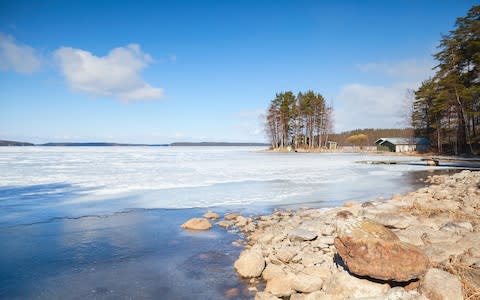How to stay alive in Europe's wildest corner

Mikko's advice is worth listening to.“We’re going deep in the woods,” he says over the phone, “And you probably won’t find it on the map. And the roads are covered in snow.
"So it’s safer if we meet at the petrol station and you can jump in my van.”
I wasn’t about to argue. As the Founder and Head Instructor of Karu Survival, Mikko Kettunen teaches bushcraft and survival skills in Finland’s Karelian wilderness, often as part of hiking or kayaking expeditions.
“Obviously, we don’t do much kayaking in the winter,” he says, “The rivers and lakes are frozen. But its my favourite time of year because, on skis, I can travel anywhere I like.”
The region of Karelia runs along Finland’s eastern border. In fact, it crosses it, because some of it is now in Russia.
“It used to all be Finland,” Mikko explains, as we wind along a road through snow-capped pine-forest. “Then in November 1939, the Soviet Union attacked, and started the Winter War.”
Stalin thought his massed troops and machinery would quickly win, but he didn’t count on the skill and tenacity of the Finns. Small groups of Finnish soldiers moved on skis to strike Red Army troops, before disappearing into the trees. The Red Army’s advance was stopped. Finland lost 11 per cent of its land, but kept its freedom.
Those skills are still integral to the Finnish military: Mikko used to be in Finland’s long-range reconnaissance unit, spending weeks operating in the wilderness, whatever the season.
“I’m from Karelia,” he says, “and being outdoors is just what we do. Everything I teach, from fire-starting to handling knives, open-fire cooking, and being safe in the wilderness, was not a hobby that we did on our holidays – it was our lives. We would come here every weekend, and we would ski to school when it snowed. So moving around in winter, and in the forest, is natural to us.”
We arrive at a hut next to some low hills. Everywhere is covered in forest, except for the white expanse of a frozen lake.
Mikko pulls a small knife from his belt and picks up a stick. Slicing downwards as he turns it, he is left with a central stick, surrounded by curls of flared wood like a peacock’s tail.

“It’s called a feather stick,” he says.
Next, he removes some felt from a metal tin, with a rock and piece of steel.
“The felt is dried fungus that grows on trees. The rock is flint. Ironically, it comes from England. British merchant ships used to bring it as ballast when trading with Helsinki.”
Placing the fungus on the flint, he strikes the stone with the steel. Sparks fly and the fungus begins smouldering red. Placing it in some shavings, rolled in bark like a cigar, he blows on it, and smoke begins to billow from the shavings.
With a crackle, the cigar bursts into flame, which Mikko places beneath a feather stick. Laying on bigger sticks, the fire is quickly roaring and Mikko places meat, onions and red peppers directly onto the coals.
Mixing water, flour, sugar and yeast in a tin, he kneads it into a dough, propped up on a log to face the flame.
“It’s a bit of an art to get open-fire cooking just right,” he says, “But give it a few goes and it’s hard to mess up. The bread is the real treat – freshly baked every time.
“Now. Let’s teach you to move in the forest.”
He clips me into a pair of forest skis: long and narrow, with a free heel and a hinged toe-binding.
“The length distributes the weight, so you don’t fall through the snow,”
To demonstrate, he walks a few paces off the path and sinks in up to his waist. Putting his skis back on, he moves off in a loping stride, one ski at a time, pushing through his poles and gliding along. The uphill was strange, but it was downhill where I came unstuck: being used to the bindings of an Alpine ski, I kept my weight forward and immediately face-planted in the deep snow.
With the long, narrow skis I couldn’t get enough purchase to push myself up, until Mikko came to my rescue.
“Everyone has the same problem,” he says, “But I can teach people from scratch in half a day.”
A post shared by Ashwin Bhardwaj (@ashbhardwaj) on Apr 2, 2018 at 10:10pm PDT
I hope I wouldn’t be a slow learner, and ask him how fast a competent skier can move.
“Well, I guess I could just show you,” he says. Clipping back in, he pushes up a ridge and begins with his loping stride. Within moments he has disappeared and I’m still looking in the direction that he has gone when I hear something behind me. Mikko has looped all the way round on the lake, hidden by the trees, faster than I could have imagined possible.
“A bit of old-school tactics,” he says with a laugh. “But these days I just use it for fun. Now, lets see how that meat’s doing.”
Getting there
Finnair flies from London Heathrow, Manchester, Dublin and Edinburgh to Joensuu, via Helsinki with fares from £129 in Economy Class. To book visit www.finnair.com or call 0208 001 01 01.
How to book
An introduction to the Karu Bushcraft course starts from €150pp to learn vital skills including; how to move around in the wilderness, how to prepare food over an open fire and how to build a shelter. The course also includes all food enjoyed during the day, all equipment, an overnight stay and material required for training as well as personal guidance from instructors. See karusurvival.com and visitfinland.com for more information.
